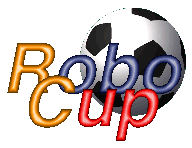| class
| javadoc
| source
| size |
Madclient
The parent program, which understands command line parameters and can
launch one or more Player threads. (Not yet complete.) |

documentation |

source |
293 |
ServerConnection
Processes packets and constructs commands to be sent to the server.
Does some final processing and sanity checking of supplied data, as well
as limiting the data rate in order to enforce the Robocup communication
speed limits. Using this class should guarantee that the client cannot
violate Robocup specifications. |

documentation |

source |
523 |
Player
A class which represents one simulated player, designed to run as its
own thread. Each Player is completely self- sufficient, which is not
optimally efficient but is a requirement of the Robocup
competition. |

documentation |

source |
67 |
World
One player's world model. Maintains two maps, one centered on the
player which contains all dynamic game objects, and another which
represents field landmarks in absolute coordinates for reference. |

documentation |

source |
362 |
GameObject
The model of any individual object in the game. Uses a probabilistic,
vector based approach to account for unreliable measurements while keeping
memory use reasonable. Much of the geometry of the world model is
contained in here (as well as in World). |

documentation |

source |
282 |
Eye
A class for parsing visual sensory information received from the
server, and integrating that information with the existing world model.
(Not yet implemented.) |

documentation |

source |
0 |
Ear
A class for parsing auditory sensory information received by the server
and integrating that information, if appropriate, to the world model. (Not
yet implemented.) |

documentation |

source |
12 |
Point
A class which represents a point or vector in two dimensional Euclidean
geometry. Uses rectangular coordinates internally, but can accept and
supply polar coordinates (without changing the vector) if asked. Also
understands the usual vector operations such as addition, scalar
multiplication, dot product, etc. Using a smart Point class greatly
simplifies the object and world models. |

documentation |

source |
109 |

